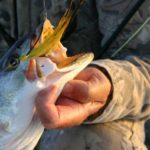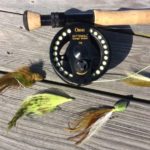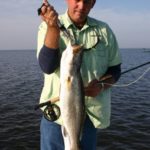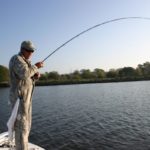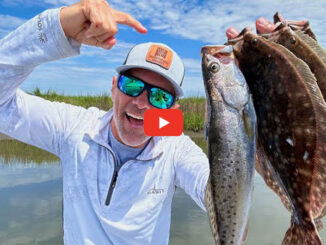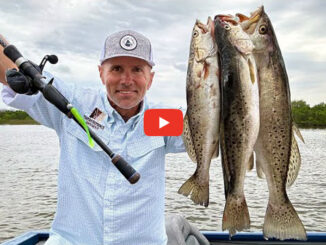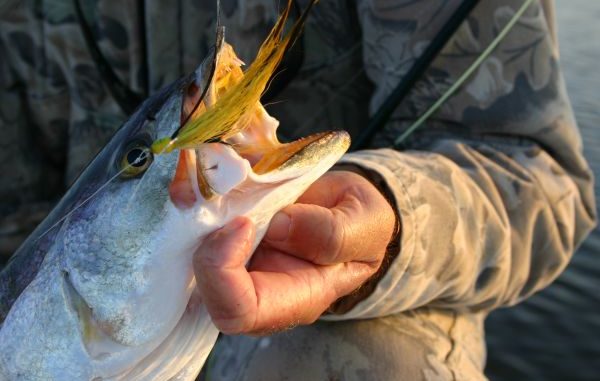
Think topwaters are the best bet for landing Big Lake’s lunker trout? This guide took the author to school, teaching the fish-catching qualities of diminutive flies.
It’s no secret that the cool-weather months are one of the best times to fish for trophy speckled trout because fish roam the shallows and there’s less boat pressure than the busy summer months.
And hard-core anglers are more than willing to trade lots of bites for fewer quality strikes.
For some, flyfishing for big trout not only ups the challenge and thrill of the sport, but has proved to be astonishingly effective to those who thinks the world stops at Corkies and MirrOdines.
I found this out the hard way one beautifully placid March morning on Big Lake. Capt. Jeff Poe, owner of Big Lake Guide Service (337-598-3268), was excited that we’d stumbled upon a morning when we weren’t nearly blown off the dock.
I was excited about building on some trophy trout momentum.
A recent long morning of throwing MirrOlure Catch 5 twitch baits had resulted in several fish over 3 pounds and a solid 6-pounder while braving the swells at east Timbalier Island.
So I was practiced and confident for whatever Big Lake could throw at me.
Poe listened and smiled at the story as he pulled up to a rather ordinary-looking shoreline on the eastern side of Big Lake, carefully multi-tasking as he checked his 8-weight fly rod and reel setup, shoring up his loop knot at the business end of his shock leader.
A hairy, dull-chartreuse offering dangled enticingly in the still, chilly early spring air.
The fly did look good in the water, but I was positive I’d have the edge when my 7-foot rod, high-performance reel and — most importantly — a half ounce of dense, hard plastic was loosed in a long, arcing cast three times the distance of the healthiest throw any flycaster could muster.
My lesson began 15 minutes into the first drift, as the first fish inhaled the fly with a bucket-sized swirl 50 feet from the boat, streaking laterally as Poe mindfully kept one eye on the 20 feet of fly line piled on the deck.
“You have to make sure your line will clear. Just make sure you know where your line is,” said Poe, as he deftly held pressure on the fly line as a 4-pounder thrashed the still surface. “If it’s a good fish, you might have to strip in a lot of line and you have to make sure your line will clear.
“Fly line just gets on everything. If you just pay attention to it, you’ll be in pretty good shape.”
Poe finally managed to entice the trout into making a run away from the boat, clearing the tangled danger zone of the deck to get the fish on the reel so he could expertly use the long rod to leverage the fish where he wanted.
That impressive start — my bait had passed through the exact water not 30 seconds before — was chalked up as expert’s skill and perhaps some bad luck on my part.
By the time the second fish — a 7-pound brute — made it to the boat, after it had had ample opportunity to see my bait first (and I’d switched to a more natural color given the clear water), I knew there was something to this fly fishing for big trout.
And that confidence I had going in? Long gone.
Poe has caught lots and lots of big fish in the spring, but even with his heavy duck-hunting schedule he said there’s no doubt that late fall and into winter are his favorite times to throw flies to Big Lake’s oversized trout population.
“It’s the simple fact that you’re going to have a whole lot more days to fish,” he explained. “When you get into spring you’re going to have days where you’re not going to want to have anything to do with it.
“In November you’re going to have a lot of nice days in between the fronts.”
Poe said there are several reasons for such success with fly tackle, whether it’s on the front end of the cool weather or the back end. Those reasons range from water clarity to fish’s familiarity with the popular baits thrown on the lake to random fish moods.
“Water clarity has a lot to do with it,” Poe said. “Those big suspending twitch baits do a great job when the water is a little off; they move a lot of water, and a lot of them have a ball (bearing) in them that makes a lot of noise.
“But when the fish don’t need to ‘feel’ the bait, a really well-tied fly will do a really good job.”
That’s not to say you won’t catch more fish on artificials if conditions are right.
“I’m not saying (a fly will) always will catch more,” Poe said.
“When they’re really biting, (a fly fisherman) won’t be able to stay with someone with conventional gear. That guy is going to get into them before you can.
“But some days a fly is going to really be the difference.”
Confidence in the craft of fly fishing also comes from the uncanny ability of a properly tied fly with natural fibers to do an enticing dance in the water, especially when the correct cadence of strips is found by the angler.
“It sits there, and it just moves so naturally. It just sits there and pulses, and just moves on its own without you doing anything,” said Poe, quickly adding that it’s essential to vary the retrieve to find the right combination on the day. “All of those materials — the chicken feathers, the deer hair, the flash material — it all looks so good in the water.”
Along with the theory of the fly’s underwater aesthetics is that of the fish population’s continual observation of many other popular baits in clear water when flies are most effective. In somewhat stained water, a water-displacing hard plastic bait is going to be found much more readily than a stealthy fly, even the bulky Deceiver.
In clear water, something that looks different and natural is more likely to draw a strike.
“They do get to see a lot of Paul Browns, a lot of MirrOdines, a lot of topwaters, and they don’t see many flies,” Poe said. “And a fly … is a good-looking bait in the water. I think a Deceiver is one of the best-looking baits in the water.
“It just looks alive. Everytime you move it, it throbs and pulses.”
And that really comes into play between fronts when big trout head out of the depths.
“I know there are some days when it does make a difference, especially when you’re in that real clear, shallow water,” Poe said. “That’s when a fly really shines. The clearer it is, the better it is. If they can see it, they’re apt to eat it.”
Poe said the theory even applies to conventional fishing at times when trout get weary of hitting the dominant walk-the-dog surface baits.
“Even in the summer, that Chug Bug or a Pop R will catch a lot of fish. I think the fact that the fish don’t see a lot of them has a lot to do with it,” said Poe.
In order to put yourself in position to catch one of these trophies on fly gear, Poe said it’s important to be able to consistently put the fly some distance from the boat. It doesn’t have to be accurate, and it certainly doesn’t have to carry 70 yards like many topwaters can, but a delicate 30-foot presentation freshwater trout anglers prefer is not going to cut it.
“You need to be able to cast 50 feet,” Poe said. “Really, what you’re striving to get is 80 or 90 feet. But realistically 70 feet would be great.”
At the same time, the veteran guide said getting the bait out there efficiently is also important, as well as being safer for any onboard who might be in the way of a wayward false cast.
“I don’t like to make more than two false casts,” Peo said. “You have to remind some people that the fish are actually in the water; they’re not in the sky.”
